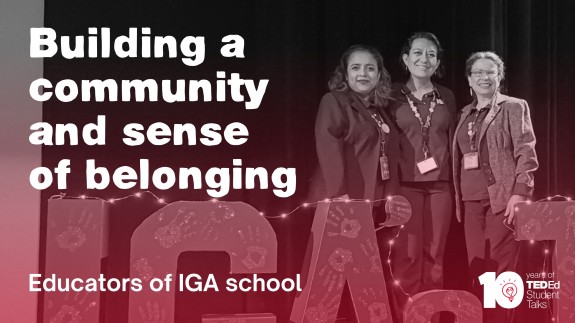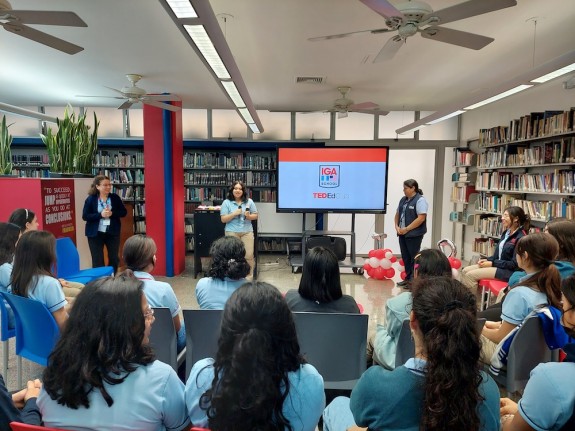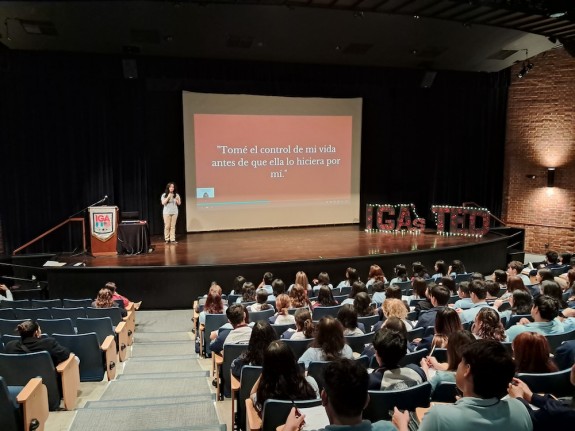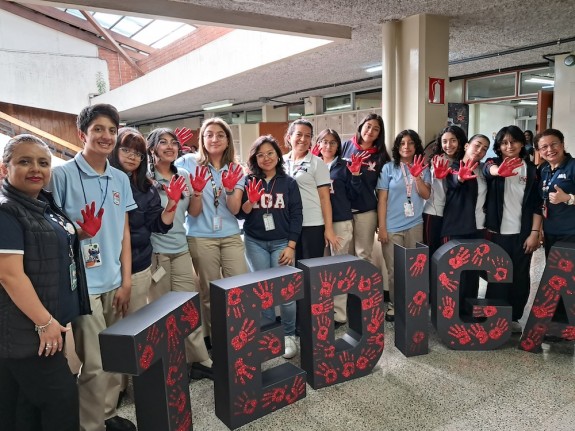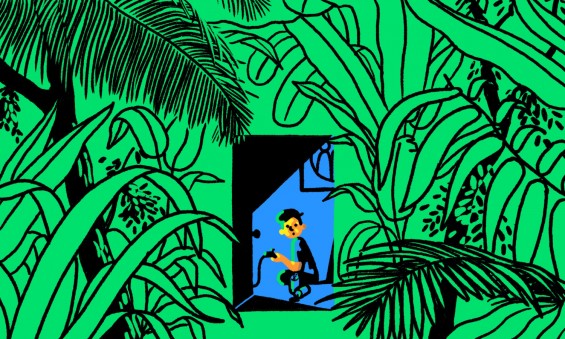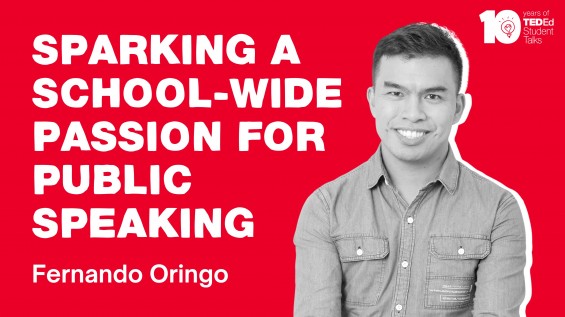
Building a community and sense of belonging: A conversation with IGA School educators
Since 2014, thousands of student groups across the globe have been developing and sharing their ideas using our free TED-Ed Student Talks resources. To celebrate 10 years of TED-Ed Student Talks, we have been collecting stories of impact from the program’s facilitators as part of our “10 for 10 years” series.
For this installment of the series, we are highlighting Cynthia Dagmara Payes, Regina Blanco, and Violeta Morales, educators from the Instituto Guatemalteco Americano (IGA) School, a bicultural institute in Guatemala.
Here, they speak with TED-Ed’s Programs Manager, Sasha Rudenko, about integrating the program into the school’s curriculum and how it helped their students develop community, motivation, and responsibility:
Sasha Rudenko (SR): Tell us about the IGA School, your role, and your students.
Cinthya Dagmara Payes (CDP): The Instituto Guatemalteco Americano (IGA) is a bicultural institute joining the best of two cultures. We have an American culture program and we also have the curriculum from Guatemala. This is a private school where students who want to grow, learn a little bit more, and go further with the English language.
SR: How did you implement TED-Ed Student Talks into IGA? How did the program fit into what you were already doing?
CDP: We had a public speaking course here at IGA because we wanted students to develop oral skills and have them share their ideas to an audience. Then [I came across] the program on the internet, I subscribed and received a newsletter every week and it said “do you want to join the TED-Ed community?” and I was very excited to do that. So, I applied and when we got confirmed, had access to the materials and were welcomed to the community, we were very, very excited. Regina was the first teacher who helped me with reading, getting engaged with the materials, the worksheets, and working with the first group of students.
Regina Blanco (RB): Our role is to be coaches to the students and [this year] we worked with seniors to prepare their talks. We divided the Student Talks manual among the four units we have at the school, and at the end of each unit they have an oral exam based on the Talks curriculum. So within their courses, they have TED-Ed — they have philosophy, they have seminar, they have math, and within those courses we use TED-Ed. We had it as an extracurricular, but now that we also have it within the curriculum, they’re excited to work on it and have new class content.
SR: If you were to pick one standout moment from your time leading TED-Ed Student Talks, what would you highlight?
RB: Something that I really love is when we see our students standing up in the theater and projecting and sharing their life experiences. That is rewarding for us because this is a challenge for them. When they are able to share, are secure, and don’t have problems with the English presentation. Our students have a high level of English, but the critical thinking that they develop in the English language is incredible. When they share that, their peers in the theater think, “my god I want to be like them!”
Another thing that we really admire is that they develop the responsibility to attend and participate in the extracurricular. They have to be on time, and complete the tasks [after finishing a full school day], and sometimes they are tired and might not want to attend. But they develop the responsibility because it’s worth it to them. They develop that consciousness about the importance of attending every single class, and that is something remarkable. They start on the very first day, attend the whole year, and then they present the talk— and behind all of that is responsibility.
Violeta Morales (VM): It was really nice to see them present their ideas, talk about their experiences, and see that they were very proud after their presentation. They felt very happy and I was very pleased to see middle school students participating for the first time in this event getting so excited.
CDP: I would say that something remarkable for me is to see them empowered and overcoming the fear of standing in front of a big audience. We had 300 students in the theater. It’s not easy to just stand in front of 300 students and share your life experiences. So seeing each of them sharing a special story, their own story, that they wanted to present and that they wanted to motivate others with was really special. And celebrating ideas in the theater with the whole community. We closed the year with a very sweet taste [knowing] that we did a good job with them and that they learned a lot.
“Our students realized that to overcome their fear of speaking and sharing personal experiences, they had to practice, practice, practice. And now they feel more confident and excited to present.”
SR: We’ve talked about confidence, empowerment, and that important moment of being on stage. What other skills have you seen students improve the most going through the activities?
CDP: I would say empathy. Once they hear someone else’s story, they generate that link with the person. Many of them identify with each other’s stories because they have been through similar things, and then they feel they are not alone. They feel like they’ve been there, it also happened to them, and there is a way to overcome it. And I think this is one of the things the TED-Ed program provides, not just for the students but for the community. Because when we celebrate their stories [at the end of the year event], the whole community is paying attention, is engaged, is happy to see them, and many of them identify with the ideas and the experiences.
SR: For you as facilitators, what has been the most challenging part about implementing Student Talks? And how did you overcome that challenge?
RB: When we start and during the process, the students have to learn how to stop and remember their past life experiences. And sometimes it’s not easy because they don’t want to go back to certain situations, but they have to take that time to look inside of themselves. At the end, they realize it is a worthy part of the process. Because through those experiences, positive or negative, they are better people. So, we have to work with them during those activities and help them see that they don’t have to be shy or nervous.
VM: I agree. Also motivating them, because some of them come to class and they are shy. We have to motivate them to continue speaking, and to share their experiences with other students. So we try to do that during the year and do activities for them to feel comfortable and happy to be in the program.
“Be passionate about the program. If you are passionate about the program [it] motivates the students, because you are motivated.”
SR: For somebody who is thinking about bringing the Student Talks program to their students, what tips would you share about how to approach it and set it up?
RB: It is important to highlight community. We work within communities and when they develop that sense of belonging, it becomes their safe place. And it’s easier to develop and form their skills. So that is something that is very, very important to visualize: the community that they might have. Making a safe place and a friendly place where they can be relaxed, they can share, and nobody is going to question them.
CDP: As a facilitator, it’s important to read all the materials to get engaged, but also to be passionate about the program. If you are passionate about the program then you’ll take the energy to the next level. And taking it to the next level motivates the students, because you are motivated and they see you being engaged with it. Something else we did was we gave them a pin, and having this pin is very important for them. They know that not everybody has one of these, and that they are special because they took on the challenge of being in the program. If they get one of these, they are brave for taking on the challenge of sharing, of learning, of growing. We gave them a pin and some t-shirts, and that gave them an identity with the community, with the program, with the institution. They feel they are a part of a whole and it makes them feel special, which is also key for this process.
VM: Adding to what you said, giving them pins and t-shirts after their presentation made them feel very proud. I think that helped a lot for this year’s students because many have asked me when the program is going to start because they want to participate. They really got motivated by seeing the other students and they want to be part of the same club.
CDP: A pencil, a pin, a t-shirt. As little as it seems, it’s something special for them. It makes them feel special. That’s a good thing.
Interested in learning more about TED-Ed Student Talks? Check out our Student Talks page here to find out how the program works and how you can get involved.
Check out the other pieces in the 10 for 10 years series here, here, here, and here.
